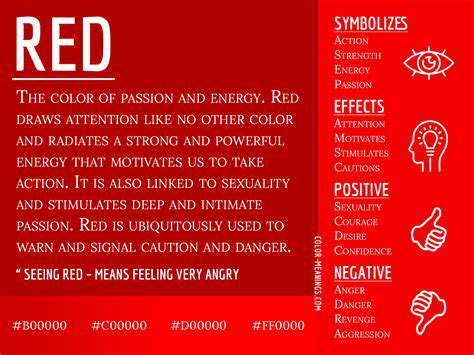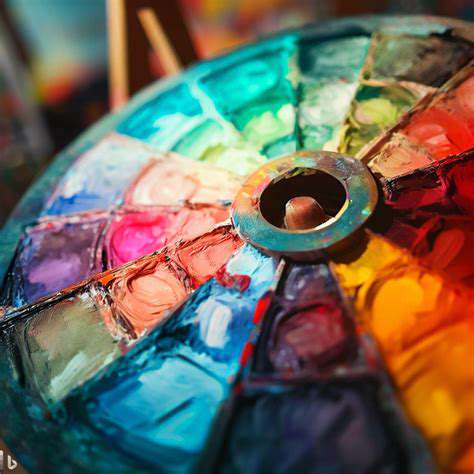How Colors Influence Emotions and Behaviors in Everyday Life
The Psychological Effects of Color

The Basics of Color Psychology
Color psychology is a fascinating field that studies how colors affect our emotions and behaviors. Different colors can evoke specific feelings and alter our mood. Understanding these effects can help individuals and businesses harness the power of color. For example, warm colors like red and orange can create a sense of urgency, while cool colors like blue and green can promote calmness.
Researchers have found that our reactions to colors can be both cultural and personal. For instance, in many Western cultures, white is associated with purity and weddings, while in some Eastern cultures, it signifies mourning. This divergence highlights the importance of context when considering the psychological impact of color.
Through the early studies of color perception, psychologists have documented various associations people make with colors. For example, yellow is often linked with happiness and energy, while black can symbolize sophistication or mourning. These associations are not universal, but they offer valuable insights into human behavior.
In marketing and branding, companies often utilize color psychology strategically. The colors chosen for logos and advertisements can influence consumer perceptions and decisions. A well-chosen color scheme can enhance brand recognition and evoke specific emotional responses.
Colors and Emotional Responses
Each color has the potential to trigger particular emotional responses, which can vary from person to person. Red, for example, might evoke feelings of excitement or passion, while blue might bring about tranquility and security. Recognizing these emotional triggers can significantly enhance interpersonal communication.
Studies have shown that color can even impact physiological responses. For instance, exposure to warmer colors can increase heart rates and stimulate appetite, making red and orange popular choices in restaurants. Conversely, cooler colors are often used in healthcare settings to promote relaxation and healing.
Our personal experiences also play a crucial role in how we perceive color. A person who associates the color green with a childhood forest might find it soothing, while another may find it unappealing due to a negative experience. This subjectivity is an essential factor in understanding the emotional effects of color.
In sum, colors do not merely exist as visual stimuli but are integral to our emotional landscapes. By becoming more aware of our reactions to different hues, we can navigate our environments and interactions with greater awareness.
Color in Cultural Contexts
Cultural backgrounds significantly shape our perceptions of color. In the West, colors like blue and pink are often gendered, associating blue with boys and pink with girls. However, in other cultures, colors may carry different meanings altogether, emphasizing the importance of context in color interpretation.
For example, red signifies good fortune and happiness in Chinese culture, often used in celebrations and weddings. In contrast, purple can represent mourning in some cultures, leading to completely different emotional frameworks surrounding this color.
Understanding these cultural implications is essential, particularly in global marketing strategies. Companies must consider local customs and values when choosing colors for branding and advertising. Failing to do so can result in miscommunication or even offense.
Ultimately, awareness of cultural associations with colors can enrich our understanding of cross-cultural communication. By acknowledging these differences, individuals can foster better relationships in a diverse world.
The Role of Color in Marketing and Branding
Color plays a pivotal role in marketing and branding strategies across various industries. A carefully chosen color palette can convey brand identity and values. For instance, luxury brands often utilize black or gold to evoke feelings of exclusivity and sophistication.
Research has indicated that up to 90% of snap judgments made about products can be based on color alone. This statistic underscores the necessity of strategic color use in marketing efforts. Brands leverage color to connect with their target audience emotionally, enhancing recognition and loyalty.
Inside stores, the color scheme can influence buyer behavior. Retailers often use warm colors to create an inviting atmosphere, encouraging longer visits and increased spending. Conversely, cooler tones tend to create a calming environment, suitable for high-end boutiques.
In the digital realm, the colors used in website design also impact user experience. Color schemes can affect readability and overall user engagement. By understanding the psychological effects of color, businesses can optimize their online presence for better performance.
Colors in Everyday Life
Colors surround us in our everyday environments, influencing our day-to-day experiences. The colors in our homes, workspaces, and public areas can affect our mood, productivity, and even creativity. Personal choices regarding color can reflect individual personalities and values.
For instance, incorporating lively colors into a home office can stimulate creativity and concentration. On the other hand, calming hues in a relaxation space can promote rest and tranquility. Creating an intentional color environment can lead to enhanced well-being.
Moreover, the colors we wear can also impact how we feel and how others perceive us. Bright colors may boost confidence and energy levels, while darker shades can communicate professionalism or seriousness. Choices in clothing color can therefore be a form of self-expression or personality projection.
In public settings, the effective use of color can significantly enhance the aesthetic appeal and functionality of spaces. Urban planners and designers often consider color psychology to create environments that positively impact communities. By recognizing the importance of color in everyday life, we can make more informed decisions about our surroundings.
The Role of Colors in Branding and Marketing
Understanding Color Psychology
Color psychology is the study of how colors affect human behavior, emotions, and decision-making. Different colors can evoke different feelings and reactions, which can significantly influence our everyday choices.
For instance, the color red is often associated with excitement and urgency, making it a popular choice for sales and clearance events. In contrast, blue is typically related to calmness and trust, which is why many financial institutions use it in their branding.
Research has shown that colors can also affect our mood and mindset, with warmer colors like orange and yellow being linked to happiness and optimism, while cooler colors, such as green and blue, may foster peace or sadness depending on their context.
By understanding the psychological impact of colors, individuals and businesses can make more informed decisions about color choices that align with their desired emotional responses and behaviors.
Color in Marketing Strategies
Marketing professionals leverage the insights gained from color psychology to design campaigns that resonate with target audiences. The strategic use of color can enhance brand recognition and consumer loyalty.
For example, a brand that wants to convey luxury may opt for black or gold to create an image of sophistication. Conversely, a brand aiming for a youthful or trendy vibe might choose vibrant colors like pink or neon shades.
Attention-grabbing colors, such as bright green or red, are often used in advertisements to stimulate action. This is particularly effective in promoting products that require immediate consumer response, like limited-time offers.
Ultimately, the deliberate use of color in marketing not only attracts attention but also communicates the brand's values and engages consumers on an emotional level.
The Impact of Colors in Interiors
The colors we surround ourselves with in our living and working spaces can significantly influence our well-being and productivity. Interior designers consider color choices carefully to create environments that evoke certain emotions.
For instance, soft blues and greens are often chosen for bedrooms to promote tranquility and relaxation. On the other hand, vibrant colors like orange can energize a home office, enhancing creativity and motivation.
Additionally, neutral colors can create a calming backdrop that allows for personal expression through decor, while bold accents can add character and vibrancy to the space.
Ultimately, the psychological effects of color can improve our quality of life by creating environments that support our emotional and functional needs.
Cultural Significance of Colors
Colors hold different meanings across cultures, making it essential to understand cultural implications when utilizing colors in global branding and product design. What may be viewed as a positive color in one culture could have negative connotations in another.
For example, while white is often associated with purity and weddings in Western cultures, it is traditionally linked to mourning in some Eastern cultures. This highlights the importance of contextual awareness in color usage.
When businesses expand into international markets, they must consider local customs and beliefs regarding color to avoid misunderstandings and ensure their message resonates positively.
The cultural significance of colors reminds us to approach color choices thoughtfully, respecting the diverse meanings that colors can hold around the world.
Trends in Color Usage
Color trends evolve over time and are influenced by cultural shifts, technological advances, and societal changes. Designers, brands, and retailers often keep a close eye on these trends to remain relevant and appealing to consumers.
For instance, recent trends reflect an increased preference for natural and earthy tones, possibly as a response to growing environmental consciousness. Colors like sage green, terracotta, and muted blues create a sense of connection to nature.
On the digital front, vibrant neon colors and gradients are making a comeback in user interface design and branding, reflecting the dynamic nature of technology and youth culture.
Staying updated on color trends allows brands to innovate and connect with consumers, ensuring they maintain a contemporary and relatable presence in a fast-paced market.
Colors and Their Cultural Significance
Red: Passion, Energy, and Warning
Red is a color that evokes strong emotions, often associated with passion, love, and excitement. It can stimulate feelings of warmth and comfort, making it popular in romantic settings.
Conversely, red also signifies danger or caution. Stop signs and warning labels often employ this color to attract immediate attention, which highlights its role as a visual signal.
In different cultures, red holds various meanings. In Chinese culture, red symbolizes good luck and prosperity, making it a favored color for celebrations and marriages.
Red can impact behavior by increasing heart rates and adrenaline levels, leading to a sense of urgency. This makes it a popular choice for brands seeking to encourage quick actions, such as fast food restaurants.
Blue: Calmness and Trust
Blue is often associated with tranquility and peace, evoking feelings of serenity. It is a color that many people find calming, often used in spaces intended for relaxation, such as bedrooms or spas.
In addition to its calming effects, blue conveys a sense of trust and reliability. Many businesses choose blue for their branding to foster a sense of security in their customers.
Interestingly, blue can also suppress appetite, making it an uncommon choice for kitchen décor. Studies have shown that people tend to eat less in blue environments.
Different shades of blue can convey different feelings: lighter shades can evoke feelings of openness and freedom, while darker shades may induce feelings of professionalism and seriousness.
Green: Nature and Growth
Green is closely linked to nature, symbolizing growth, renewal, and life. It evokes feelings of balance and harmony, making it a popular choice for promoting wellness activities and products.
The association with nature makes green a preferred color in environmental movements, where it represents sustainability and ecological balance.
Psychologically, green can provide a sense of calm and restoration. Many people find that exposure to green spaces reduces stress and enhances overall mood.
With a spectrum that ranges from vibrant lime to deep forest, green can influence emotions in varied ways. Bright greens can energize and refresh, while darker shades often promote a sense of stability and reassurance.
Yellow: Optimism and Happiness
Yellow is often considered the color of sunshine, associated with warmth, happiness, and optimism. It can stimulate feelings of joy, making it a popular choice in designs aimed at uplifting mood.
However, yellow can also be overwhelming in large doses, potentially leading to feelings of frustration or anxiety. This highlights the importance of balance when using yellow in design and decor.
From a cultural perspective, yellow can hold different meanings. In certain cultures, it represents wealth and power, while in others, it signals caution.
It is also worth noting that yellow is the most visible color in the spectrum, making it effective for attracting attention. This quality is why it is often used in advertising and promotional materials.
Purple: Luxury, Mystery, and Creativity
Purple has long been associated with royalty, luxury, and sophistication. Historically, the dye used to create purple was expensive and rare, leading to its connection with wealth and high status.
Beyond its luxurious appeal, purple can also stimulate the imagination, making it a favorite among creative individuals. It is frequently used in settings designed to inspire artistic endeavors.
In different cultures, purple can symbolize a range of ideas, from spirituality in some regions to mourning in others. This duality can make purple a complex color to use in design.
Various shades of purple can evoke different emotions as well. Lighter lavender shades may be calming and feminine, while deeper eggplant hues can convey strength and sophistication.
Enhancing Daily Life through Color
Understanding the Psychological Impact of Colors
Colors have a profound effect on human psychology, influencing our emotions, perceptions, and even behaviors. Research has shown that different colors can elicit distinct emotional responses, such as feeling calm when surrounded by blue or energized by vibrant red hues. This association between color and emotion is rooted in various cultural, personal, and environmental factors.
For example, green is often associated with nature, tranquility, and refreshment, leading many people to feel relaxed and rejuvenated in its presence. Meanwhile, yellow is frequently linked to happiness and optimism, stimulating feelings of joy and approachability. These inherent connections can be leveraged in various settings, from workplaces to home decor, to create desired emotional atmospheres.
Understanding the psychological impact of colors can empower individuals to make intentional choices about their surroundings. By selecting colors that align with desired moods, one can enhance productivity, relaxation, or creativity. This knowledge is especially valuable in design, branding, and marketing, where color can significantly influence consumer behavior and engagement.
In conclusion, awareness of the psychological effects of colors can lead to improved emotional well-being and more effective communication in daily life. By consciously integrating colors that resonate positively, individuals can cultivate environments that support their mental and emotional goals.
Colors in Marketing and Brand Identity
Colors play a crucial role in marketing and brand identity, as they help convey messages about products and services. Marketers carefully select color palettes to evoke specific emotions and spark consumer interest. For instance, the use of red in branding often signifies urgency, which can encourage impulsive purchasing behavior.
Moreover, brand recognition is significantly influenced by color; studies indicate that up to 90% of snap judgments about products can be based on color alone. Brands like Coca-Cola and Starbucks have successfully built their identities around distinct color schemes that evoke strong emotional connections with their audiences.
In addition, color consistency across branding, packaging, and advertising helps reinforce brand identity and recall. When consumers associate a color with a brand, it creates a visual shorthand that can convey trust, quality, and attributes unique to the brand. This is why companies invest time and resources into developing a cohesive color story that aligns with their brand values.
Overall, understanding the psychological implications of color in marketing can be a pivotal strategy for businesses aiming to connect with their audience on a deeper emotional level. Companies that harness the power of color effectively can enhance brand loyalty and increase customer engagement.
The Role of Color in Home Environments
The colors we choose for our homes can significantly impact our daily lives and well-being. For example, soft neutrals and pastels can create a calming effect, making them ideal for bedrooms or relaxation spaces. On the other hand, bold colors like orange can inject energy and vibrancy into common areas such as kitchens or living rooms.
Interior designers often employ color theory to craft spaces that evoke specific feelings or moods. By selecting appropriate color palettes, they can transform an environment, making it more inviting, comforting, or stimulating, depending on the desired outcome. Warm colors tend to feel more intimate and cozy, while cool colors can create a sense of openness and tranquility.
Furthermore, the influence of natural light on color perception cannot be overlooked. Colors may appear differently at various times of the day, and a room's orientation can greatly affect its ambiance. For instance, a sunny room may make a yellow hue appear vibrant and cheerful, while the same hue might seem dull in a shadowy space.
In essence, the strategic use of color in home decor is a powerful tool for crafting environments that support emotional well-being and enhance quality of life. Homeowners can benefit from taking the time to evaluate the colors in their living spaces, ensuring they align with their personal aesthetic and emotional needs.
Color and Cultural Significance
Colors often carry cultural meanings that can vary significantly between societies. For instance, while white is associated with purity and new beginnings in some Western cultures, it can symbolize mourning in certain Eastern cultures. Understanding these variations is crucial for effective communication and expression in diverse settings.
Festivals and traditional ceremonies also highlight the significance of specific colors. For example, the color red is considered auspicious in many Asian cultures and is prominently featured during celebrations such as weddings and New Year festivities. Such cultural associations with color can influence choices in clothing, decorations, and even food.
Moreover, symbolism associated with colors can evolve over time. Certain colors may take on new meanings due to social movements or historical events, reflecting shifts in collective consciousness and identity. For instance, the color pink has been redefined as a symbol of breast cancer awareness, transforming its connotation from purely feminine to one of advocacy and empowerment.
In conclusion, the cultural significance of colors is a fascinating area that underscores the depth of color psychology. By appreciating the various meanings attached to colors across different cultures, individuals can foster a greater understanding and respect for diverse perspectives, ultimately enriching their own experiences in an increasingly interconnected world.



